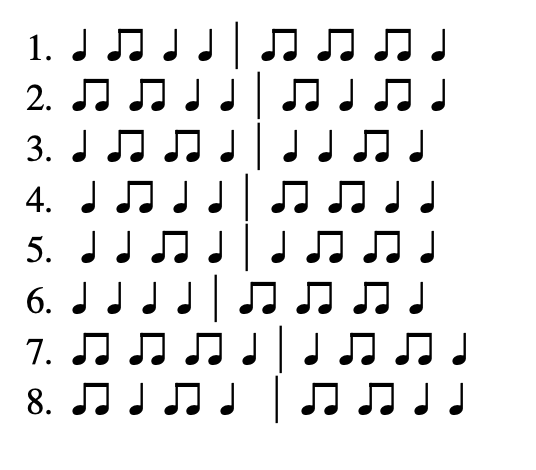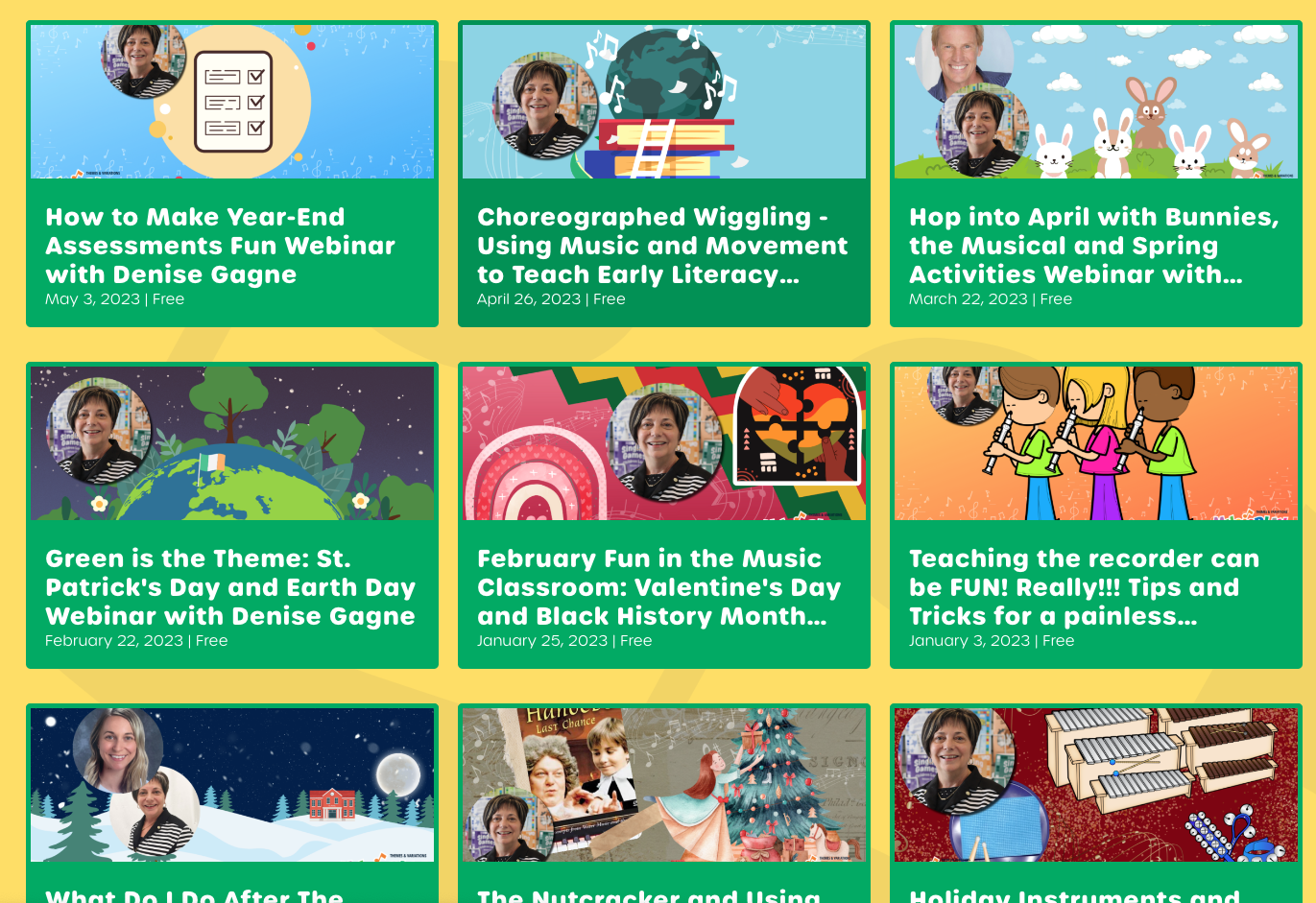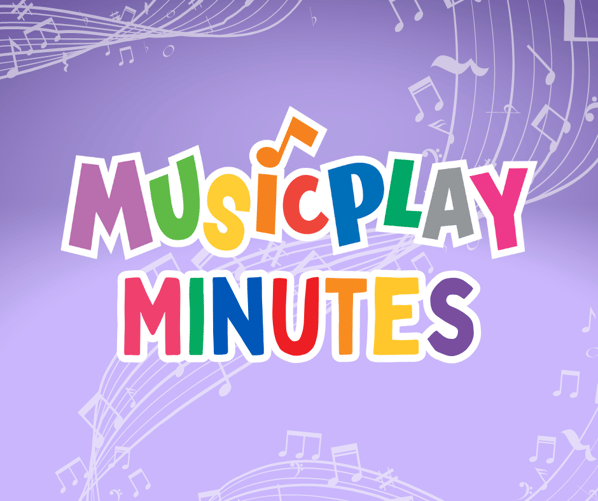Rhythm Assessment

In Musicplay K-6, many assessment ideas are included. In this newsletter, I’ll highlight some easy ideas for assessment of rhythm reading and writing. Students in elementary school are most often able to read language and literature at a greater difficulty level than they can write. The same is true of rhythm. In assessing students ability to read and write rhythms, include assessment of both the ability to read, and the ability to write or notate a rhythm that they have heard.
Read the rhythm - Pairs of Flashcards
“Rhythm Flashcards” published by Themes & Variations (found here) provides 100 different flashcards starting with simple ta, titi rhythms. For this activity, use only those rhythms that your students have spent many weeks reading in flashcards and in songs that they sing. Put magnets on the back of your flashcards and hang them on a magnetic board, or place pairs of flashcards in a pocket chart. Have 6-8 different pairs of flashcards. The first student reads the first pair and you assess, the second student reads, and so on. After the last pair of flashcards has been read, have the next student start at the top of the list and use all the pairs again. If you do not have flashcards, write eight different two-measure rhythm patterns on the board.
For example:

Rubric:
1- Advanced: maintains steady beat while confidently and accurately saying the rhythm names
2- Proficient: rhythm names are correctly named, but not always performed perfectly with a steady beat
3- Developing: rhythm names are correctly named, but are only occasionally performed perfectly with a steady beat
4 - Not Yet: rhythm names are not named correctly or performed with a steady beat
Which rhythm did I play?
(2-3 flashcards or worksheet with 2-3) Circle one If you have “Rhythm Flashcards” published by Themes & Variations , choose 6-8 pairs of rhythms to assess. These should be rhythms that your students have worked on for a month or more. Put magnets on the back of your flashcards and hang them on a magnetic board, or place pairs of flashcards in a pocket chart. Have 6-8 different pairs of flashcards. If you do not have flashcards, write eight different two-measure rhythm patterns on the board.
The teacher asks the children to write the rhythm that she claps. Tell the children, “Pair #1: Which rhythm did I clap?” Be sure to clap the rhythm accurately and with a steady beat. Keep track of which rhythm you did clap, so you can mark the assignments.
You can make up a worksheet with 2 or 3 rhythm patterns, and have the students circle the rhythm that you clapped. For young students this is even easier than having them write the rhythm down on a piece of paper.
Rubric: No rubric is required for this activity. Students will receive a mark based on how many questions you give them. You don’t need to do many questions to get an accurate assessment of how well your students are reading. 5-8 rhythms should be sufficient.
Games to Prepare for Rhythm Dictation:
Allegro vs Vivace - the half and half game
This game is preparation for rhythm dictation. Choose 8-10 flashcards with rhythms that your students have been working on. Divide your class into two groups. Call one group the Allegros, and the other group the Vivaces. Show one flashcard (4 beats) to the Allegros and have them clap the rhythm. Either conduct them, or count 1-2 ready go so that they begin together. If the Allegros clap the card accurately they get a point. The Vivaces have to “say” the rhythm that their opponents clapped. If they “say” it correctly, they get a point. The team with the most points wins the game. It is really preferable if you can engineer a tie before the class goes out for recess.
Hula Hoop Game:
For this game you’ll need 12 hula hoops. Divide your class into 3 teams with 8 students on each team. For each team, set out 4 hula hoops that will be their 4 “beats”. Clap a rhythm. Each team has to create the rhythm that was clapped in the hula hoops.

This is the rhythm of the phrase: Hey Betty Martin - ta titi ta ta
Notation Games: Relay race to the board
Divide your class into four teams. Line them up as far away from whiteboard or blackboard as you can. Clap a rhythm. The first child in each team races to the board and writes the rhythm. The first child to correctly write the rhythm wins a point. Award points for ties. The team with the most points at the end of class wins.
The Gossip Game: Tap the shoulders
Divide your class into 4-6 teams. Have the teams sit on the floor in a line, facing the whiteboard. Choose a rhythm that you will tap on the shoulders of the last child in the line. That child passes the rhythm to the next child in the line by tapping her shoulders. The rhythm is passed to the front of the line. The first person in the line writes the rhythm on the board. The team that correctly writes the rhythm wins the game.
Rhythm Dictation: Write the rhythm that you hear
Rhythm Dictation can be started as early as Kindergarten by using manipulatives instead of pencils and paper. You can make up ziplock bags with coffee stir sticks or craft sticks, and have the students create ta and titi patterns using sticks. Later in first grade and from second grade on, students can write rhythm dictations using pencil and paper. If you give the students the ziplock bag or the pencil/paper as they enter the music classroom, it will save the time it would take to hand these out to all your students. Base the dictation on rhythms or short song fragments that are familiar to your students.
Write the rhythm of a song or poem.
Ultimately, I’d like my students to have the ability to notate the rhythm of a song or a poem that they hear. They will have had some preparation to do that by notating song fragments as int he rhythm dictation activity. Composing with word rhythms will also help to prepare them for this. One favorite activity of all the students I’ve taught is the rhythm erase.
Rhythm erase:
Choose a song or poem that the students are very familiar with. Many suggestions are given throughout Musicplay of songs that would work well as rhythm erases. We’ll use “Hey Betty Martin” from Musicplay 2.
Hey Betty Martin tip-toe, tip-toe
Hey Betty Martin tip-toe fine.
Write the rhythm of the song on the board. Have the students say the rhythm, or say and clap it. Erase one measure. Have the students say all four measures - the three that are written and the one that has been erased. Erase another measure. Have the students say all four measures - the two that are written and the two that have been erased. Erase another measure. Have the students say all four measures - the one that is written and the three that have been erased. Erase the last measure. Have the students say all four measures. Invite four students to come to the board and write one of the measures that was erased. Have all the class check the work. Say the rhythm of the entire song again and check that it is correct.
Mixed up Measures:
Write the rhythm of a song or poem that the students know well on the board in mixed up order. Invite individual students to put the poem or song in correct order. If you are doing this as an assessment, have the students write the rhythm of the song or poem on their paper in correct order.
Musicplay Workshops
Registration for Musicplay Live in Washington, DC; Austin, TX; and Virtual is open!
Check out our collection of FREE webinars here!

Musicplay Minutes Podcast

Listen to our newest podcast on ideas for St. Patrick's Day and Earth Day!

.png?width=483&height=405&name=MusicplayLive%202023%20Sing!%20Say!%20Dance!%20Play!%20With%20Artie%2c%20Denise%2c%20and%20JJ%20Locations%20FB%20(2).png)